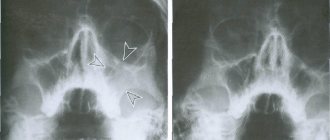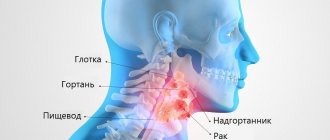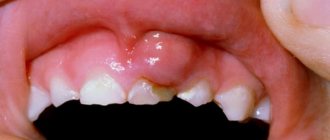A sore throat is a symptom that probably each of us has encountered. But a sore throat is not always associated with colds. There are many reasons why your throat hurts. And they are not always directly related to ENT diseases. Why does my throat always hurt? How to treat this condition correctly and which doctor should I contact for treatment? You will find answers to all questions in our new article.
Many patients come to see an otolaryngologist with the complaint: “I constantly have a sore throat.” Indeed, a sore throat is a common symptom that forces a person to consult an ENT doctor. Please note that this is a symptom, that is, only a manifestation of a certain disease, and not a full diagnosis. There are many reasons that cause discomfort and pain in the throat. Let's figure out why your throat often hurts.
The causes of sore throat are divided into infectious and non-infectious.
Of course, the vast majority of cases of sore throat are associated with pathogens of infectious diseases. In any case, no matter what is the cause of discomfort in the throat and larynx, and especially pain that occurs frequently or lasts constantly, such a condition cannot be tolerated. It is necessary to contact a competent otolaryngologist who will determine why your throat constantly hurts and suggest effective treatment tactics.
What can cause a sore throat? The following causes of throat disease are identified:
- viral diseases (ARVI, influenza, etc.);
- pharyngitis;
- tonsillitis;
- laryngitis;
- fungal diseases;
- neuralgic conditions;
- burns and injuries of the larynx;
- benign and malignant neoplasms;
- allergic reactions;
- diseases of other human organs and systems.
As we can see, there are many reasons why the throat often hurts. And it is impossible to determine the real cause of this condition without an ENT doctor. Often you have to resort to consulting doctors of related specialties, for example, an allergist.
Infectious causes of pain
A throat infection is the most common cause of sore throat. The causative agents of infectious diseases are viruses, bacteria and fungi.
Viral causes include primarily acute respiratory diseases, influenza, measles, and rubella. In addition to pain in the throat, the patient complains of the following symptoms: pain when swallowing, headaches, runny nose, nasal congestion, cough, fever, weakness, loss of appetite. These diseases are quite easily diagnosed at the first visit to a doctor. If you approach the treatment of your throat and the disease in general responsibly and follow all the doctor’s recommendations, the symptoms will subside within a week.
Bacterial infections provoke the development of tonsillitis, bacterial pharyngitis and laryngitis. One of the symptoms of these diseases is constant pain in the throat.
Acute tonsillitis is a well-known sore throat. The disease manifests itself as acute inflammation in the palatine tonsils. With this disease, the throat hurts very much. It is extremely difficult for the patient to swallow, and the body temperature rises to 40℃. If left untreated, the disease can develop into a chronic condition, with symptoms recurring throughout the year. In its most advanced state, the disease can cause serious complications when it hurts not only in the throat, but also affects other human organs and systems. Thus, chronic tonsillitis often causes the development of diseases of the kidneys, heart and joints.
Another disease that causes pain in the throat is pharyngitis, which is an inflammation of the mucous membrane of the pharynx. Why does pharyngitis occur? Most often, pharyngitis occurs as a consequence of inflammatory diseases of the upper respiratory tract. Also, inflammation of the pharyngeal mucosa can be caused by too hot or spicy food, alcohol, or inhalation of cold air.
Laryngitis also causes pain in the larynx. In addition to this symptom, the patient complains of soreness and itching, pain when swallowing, and hoarseness in the voice. A person experiences similar symptoms when there is a fungal infection of the pharyngeal mucosa.
All these conditions require competent treatment under the supervision of an ENT doctor.
Acute laryngitis - symptoms and treatment
The larynx (Larynx) is a conventional boundary separating the upper and lower respiratory tract. This is a kind of musical instrument in the human body that gives voice. It is built on the principle of a movement apparatus - it contains a skeleton (cartilages of the larynx) and its connections (ligaments and joints). This frame has two bands of muscle (vocal cords) that run along the top of the windpipe (trachea). The movements and vibrations of these muscles allow us to speak, sing and whisper.
In addition to the voice-forming function, the larynx also performs a protective function. When we swallow, the larynx closes its opening so that food and liquids enter the esophagus rather than the airways [4].
Regardless of the cause, inflammation causes swelling of the vocal cords and narrowing of the space between them. Protein breakdown occurs, which leads to an increase in osmotic and oncotic pressure in damaged tissues. Due to the difference in pressure, fluid rushes into the damaged area, which leads to the appearance of edema. Changes appear in the mucous membrane of the larynx:
- Catarrhal (associated with inflammation of the mucous membranes): hypersecretion of the mucous glands, swelling, redness. Observed during viral infections.
- Severe swelling - with allergies.
- Infiltrative (accumulation of cells mixed with blood and lymph in the tissues of the body) - characteristic of neoplasms and chemical lesions (when exposed to acids, alkalis and other caustic liquids);
- Purulent - for bacterial infections [5].
In response to irritants, the mucous membrane of the larynx begins to produce mucus, which can also clog the respiratory lumen, like a plug. Mucus is produced by special cells called goblet cells. They are located in the mucous membrane and submucosal glands. Mucus serves to protect epithelial cells from infectious agents, allergens and irritants. This is why smokers suffer from a constant cough with sputum production. Increased mucus secretion in the respiratory tract is a marker of many common diseases, such as acute respiratory viral infections or allergies.
Due to swelling of the mucous membrane, the vocal cords thicken and cannot vibrate, the voice changes, becomes hoarse or disappears altogether. In severe cases, the ligaments can practically close, causing shortness of breath and noisy, hoarse breathing due to the inability to take a breath. This condition is called laryngeal stenosis, another name is false croup (from the Scottish “croup” - to croak). This life-threatening condition, which is characterized by a barking cough, is often accompanied by inspiratory dyspnea (difficulty breathing) and hoarseness of the voice. Usually observed in children aged 6-36 months, most often against the background of a viral infection: parainfluenza - 50%, influenza - 23%, adenovirus infection - 21%, rhinovirus infection - 5% [6].
Why your throat constantly hurts: non-infectious causes
Pain in the throat may not be associated with ENT diseases, but may be a manifestation of neurological disorders. Why does this symptom appear with neuralgia? In stressful situations and mental disorders, nerve spasms occur. Usually this condition is accompanied by a feeling of a lump in the throat, difficulty swallowing, and headaches. This feeling can manifest itself constantly, or maybe with a certain frequency.
Various external factors can cause pain: mechanical injuries to the larynx, chemical or thermal burns. Hard pieces of food and bones can injure the larynx. Chemical burns can be caused by inhaling vapors of harmful substances at work or by ingesting harmful substances while eating. Thermal burns most often occur when eating hot foods or drinks.
Benign and malignant neoplasms of the pharynx and larynx can also cause pain. Moreover, malignant tumors can cause quite severe pain. In this case, determination of the cause and treatment must be immediate so that the disease can be managed and the prognosis for recovery is favorable.
Pain in the throat can occur under the influence of an allergen. Allergens can include food, plant pollen, house dust, fur and excretions of pets, etc. In addition to discomfort in the throat, an allergic person constantly sneezes, has a stuffy nose, a severe runny nose and itchy eyes.
Unpleasant sensations in the pharynx and larynx are not always associated with ENT diseases. Sometimes this symptom is an echo of pathological processes occurring in other human organs, for example, diseases of the thyroid gland, osteochondrosis, gastroesophageal reflux.
One way or another, no matter what the reason causes discomfort, it is necessary to treat the throat, and the treatment should be carried out under the supervision of a doctor.
“Throat and stomach hurt,” or what do you know about adenovirus
During seasonal ARVI, cough and sore throat are an “expected” phenomenon. But what if traditional respiratory symptoms are combined with diarrhea or vomiting? Perhaps it is an adenoviral infection.
Special signs
Adenovirus, unlike many respiratory viruses, affects not only the respiratory tract, but also the mucous membrane of the small intestine. In addition, the conjunctiva of the eye comes under attack.
It leads to:
- copious mucous discharge from the nose,
- sore and sore throat,
- cough (first dry, and later with sputum),
- symptoms of conjunctivitis, such as redness of the eyes, watery eyes, a feeling of dryness and “sand” in the eyes,
- as well as abdominal pain, diarrhea, vomiting
- and fever, the duration of which can reach 2 weeks.
Moreover, if intestinal symptoms may not develop during the entire infection, then the “characteristic” eyes are an important distinguishing feature of the adenovirus.
Where can you get infected?
Adenovirus is extremely infectious and resistant in the external environment. And the source of infection can be sick people or household items on which the virus remains active for up to 8 days.
You can become infected:
- when the patient coughs and sneezes,
- consuming food prepared without sanitary standards (thorough hand washing is required),
- and even through contact with the feces of an infected person (for example, when changing a diaper for an infected child).
You can “catch” the virus even in a swimming pool if the water is not properly disinfected. And, obviously, this viral infection is not uncommon in children's groups.
How dangerous is this?
Adenovirus infection, in most cases, does not pose a threat to health or life. And it usually ends without consequences after 7-14 days. Whereas in weakened patients, the infection can drag on and reach 6 weeks.
This same category of patients most often develop complications in the form of:
- pneumonia,
- otitis,
- bronchospasm
- severe keratoconjunctivitis.
However, Rospotrebnazor experts note that complications of adenoviral infection are always associated with the addition of pathogenic bacterial flora (staphylococci, streptococci and others).
How to identify adenovirus
The classic symptoms of adenoviral infection, as a rule, do not require additional tests. And the help of laboratory diagnostic methods is mainly resorted to at the earliest stage of the infectious process or in case of doubt about the diagnosis.
The most informative analysis in this case is PCR diagnostics of the material (throat swab or feces) for adenovirus.
The study can be ordered separately or immediately in combination with other ARVI viruses (for example, “ARVI-Screen”), which will allow you to immediately carry out a differential diagnosis. True, the PCR technique sharply loses its reliability if treatment, both local (rinses, sprays) and general, has already begun.
A blood test for IgA antibodies to adenovirus does not have these shortcomings.
They appear in the blood during the initial period of the disease, and continue to circulate for some time after recovery.
However, children, as you know, “don’t like” blood tests, so this examination format is more suitable for adults.
Treatment for sore throat
Traditionally, we treat the throat with popular and affordable remedies that relieve symptoms. But such treatment is not complete, because it does not eliminate the cause of severe sore throat. In addition, eliminating symptoms can cause complications.
The main general recommendations for the treatment of sore throat include: avoiding excessively hot, cold, spicy, rough foods; to give up smoking; reducing the load on the vocal cords; ventilation of premises; air humidification; drinking large amounts of liquid; rinsing; lozenges.
Frequent and abundant warm drinks will help soften the pharyngeal mucosa: plain drinking or still mineral water, herbal teas, rosehip decoction. The total amount of liquid is at least 2 liters per day.
Before buying tablets for sore throat for adults, it is worth understanding the causes of pain and assessing additional symptoms and manifestations. In most cases, a consultation with a doctor is required to accurately diagnose and select the correct treatment. It is especially important to see a doctor when the pain is severe and accompanied by prolonged fever and a hacking cough. It is important to pay attention to the condition of the lymph nodes under the jaw, behind the ears, on the neck, to note nasal congestion and skin changes.
Choosing an effective drug that will quickly, carefully and without side effects relieve a sore throat will be much easier if you know what exactly caused the disease. Bacteria, germs or fungal colonies, and maybe even physical damage to the larynx. In each case, different medications are used for treatment. Medicines that need to be absorbed are widely used, however, other forms of medicines can be found in pharmacies: effervescent tablets, lozenges, syrups and other liquid forms, sprays, soluble powders, lubricants, aerosols.
If the sore throat is caused by bacteria, then the best choice is a spray with a pronounced antiseptic effect. It is important to consider that with prolonged use, infectious agents develop resistance to the drug, so if after 2-3 days you do not feel relief, the medicine needs to be changed. For a disease of viral origin, it is best to choose a throat spray that relieves pain and fights inflammation. In the case of chronic pain, it is necessary to regularly irrigate the throat with a spray with a moisturizing effect that does not contain aggressive substances and carefully relieves unpleasant symptoms.
Many drugs reduce symptoms due to the local anesthetics they contain - phenol, benzocaine or dyclonine. Under their influence, the mucous membrane becomes numb and the pain noticeably weakens. The prescription of a number of drugs is limited by their high allergenicity and irritating effect. This includes drugs containing iodine derivatives, propolis, and sulfonamides. Preparations containing herbal antiseptics and essential oils are effective and harmless, but their use is contraindicated in patients suffering from allergies to pollen, and the number of people with this disease in some geographic areas is up to 20% of the population.
As for improving the general condition, for example, eliminating fever, NSAIDs for oral administration are suitable here: paracetamol, ibuprofen, naproxen. For the treatment of children, various experts recommend using either ibuprofen or paracetamol. Drinking plenty of warm drinks and sucking on lollipops (even regular ones, not pharmaceutical ones) will help relieve a sore throat. Constantly moisturizing and washing the inflamed mucosa softens the discomfort and promotes a speedy recovery.
TOP 5 drugs in the format of tablets (lozenges) for resorption
- Hexalize, with lysozyme, enoxolone and long-acting antiseptic biclotymol. It has a combined antiviral and antiphlogistic effect. Indicated in the treatment of pharyngitis, pharyngolaryngitis, tonsillitis, glossitis. Not for use in children under 6 years of age or in case of hypersensitivity.
- Falimint, dragee with the substance acetylaminonitropropoxybenzene. Has an analgesic and disinfecting effect at the site of application. Used for laryngitis and other diseases of the oropharynx. Contraindicated during pregnancy, breastfeeding and with high sensitivity to the components.
- Septolete Neo. Lollipops have a disinfectant, anti-inflammatory, refreshing, and antitussive effect. Contains cetylpyridinium chloride monohydrate, active against fungi, microbes, viruses (for mild infections of the oropharynx and oral cavity). Not prescribed if you are allergic to the components.
- Faringosept, tablets based on the substance ambazone monohydrate with a disinfectant, antiphlogistic and bacterial growth-stopping effect. Used for acute inflammation of the larynx and oral cavity. Do not use if you have an allergic reaction to the active ingredients or other components.
- Strepsils, antiseptic and decongestant tablets with amylmetacresol and dichlorobenzyl alcohol. Recommended for children over 6 years of age and adults with pathologies of the pharynx. Do not use if you are hypersensitive to the substances contained in the composition.
Treatment of throat during pregnancy
You can find articles containing traditional methods of treating a throat during pregnancy, but do not rely on them completely - if you have the slightest doubt about the adequacy of a prescription, discuss it with your doctor. The only absolutely harmless thing is gargling with a saline solution or a decoction of soda - the proportions are 1 teaspoon per glass of warm water, gargling with an infusion of chamomile, eucalyptus, or gargling with a solution of Miramistin, Furacilin or Chlorhexidine.
Among the medications, the following are relatively safe: Hexoral (2 times a day, one dose), Ingalipt, Lizobakt, Faringsept, Stopangin (allowed in the 2nd and 3rd trimester). After any throat treatment, you should refrain from eating and drinking for half an hour.
Back to articles









